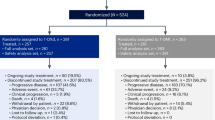Abstract
Agents capable of reversing P-glycoprotein-associated multidrug resistance have usually failed to enhance chemotherapy activity in patients with solid tumours. Based on its toxicity profile and experimental potency, dexverapamil, the R-enantiomer of verapamil, is considered to be promising for clinical use as a chemosensitizer. The purpose of this early phase II trial was to evaluate the effects of dexverapamil on epirubicin toxicity, activity and pharmacokinetics in patients with metastatic breast cancer. A two-stage design was applied. Patients first received epirubicin alone at 120 mg m(-2) i.v. over 15 min, repeated every 21 days. Patients with refractory disease continued to receive epirubicin at the same dose and schedule but supplemented with oral dexverapamil 300 mg every 6 h x 13 doses. The Gehan design was applied to the dexverapamil/epirubicin cohort of patients. Thirty-nine patients were entered on study, 25 proceeded to receive epirubicin plus dexverapamil. Dexverapamil did not increase epirubicin toxicity. The dose intensity of epirubicin was similar when used alone or with dexverapamil. In nine intrapatient comparisons, the area under the plasma concentration-time curve (AUC) of epirubicin was significantly reduced by dexverapamil (mean 2968 vs 1901 microg ml[-1] h[-1], P= 0.02). The mean trough plasma levels of dexverapamil and its major metabolite nor-dexverapamil were 1.2 and 1.5 microM respectively. The addition of dexverapamil to epirubicin induced partial responses in 4 of 23 patients evaluable for tumour response (17%, CI 5-39%, s.e.P 0.079). The remissions lasted 3, 8, 11 and 11+ months. These data suggest that the concept of enhancing chemotherapy activity by adding chemosensitizers may function not only in haematological malignancies but also in selected solid tumours. An increase in the AUC and toxicity of cytotoxic agents does not seem to be a prerequisite for chemosensitizers to enhance anti-tumour activity.
This is a preview of subscription content, access via your institution
Access options
Subscribe to this journal
Receive 24 print issues and online access
$259.00 per year
only $10.79 per issue
Buy this article
- Purchase on Springer Link
- Instant access to full article PDF
Prices may be subject to local taxes which are calculated during checkout
Similar content being viewed by others
Author information
Authors and Affiliations
Rights and permissions
About this article
Cite this article
Lehnert, M., Mross, K., Schueller, J. et al. Phase II trial of dexverapamil and epirubicin in patients with non-responsive metastatic breast cancer. Br J Cancer 77, 1155–1163 (1998). https://doi.org/10.1038/bjc.1998.192
Issue Date:
DOI: https://doi.org/10.1038/bjc.1998.192
This article is cited by
-
BCRP Transports Dipyridamole and is Inhibited by Calcium Channel Blockers
Pharmaceutical Research (2005)



